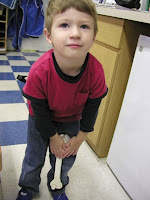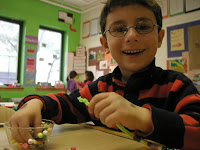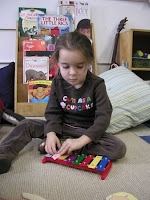Buzz Buzz:
Our examination of bugs and insects continued this week, and the children began to make drawings based upon some of the toys we have in the classroom. Drawing what you see isn't always easy, but they enjoyed doing this, and even added creative touches such as leaves for the insects to rest on (below).


We are incredibly fortunate to have the absolutely beautiful community garden just down the block from our school. It makes for a quick and easy trip, and we are able to make some great observations about nature. It's like our own little Eden. It's peaceful, well-kept, and at this time of the year, very colorful! The children noticed many things about leaves during our trip, and they loved looking at the ENORMOUS leaf (below), which was bigger than most of the children. They also enjoyed collecting acorns from the ground. One child noted that "squirrels eat the acorns or they move them around." We used this idea to talk about how some animals are great 'helpers,' doing their job to spread seeds around, or how bees spread pollen around.





We then used some of the leaves that we collected from the community garden to make leaf rubbings, as well as observational art, which are on display above the meeting rug in the classroom. We have noticed that leaves come in many different shapes and sizes. We read a book about why the leaves are changing colors, in which we learned that during the year, the leaves are 'already' red, yellow, or orange, but since there is so much sunlight during spring and summer, the leaves produce more chlorophyll to feed the trees. More chlorophyll = more green. Basically, the green color is masking the colors that we later see in the fall, when there is less sunlight, so less chlorophyll. Fascinating! We talked about how trees are going to 'hibernate' through the winter, and we talked about some other animals that also hibernate.Our examination of bugs and insects continued this week, and the children began to make drawings based upon some of the toys we have in the classroom. Drawing what you see isn't always easy, but they enjoyed doing this, and even added creative touches such as leaves for the insects to rest on (below).


We are incredibly fortunate to have the absolutely beautiful community garden just down the block from our school. It makes for a quick and easy trip, and we are able to make some great observations about nature. It's like our own little Eden. It's peaceful, well-kept, and at this time of the year, very colorful! The children noticed many things about leaves during our trip, and they loved looking at the ENORMOUS leaf (below), which was bigger than most of the children. They also enjoyed collecting acorns from the ground. One child noted that "squirrels eat the acorns or they move them around." We used this idea to talk about how some animals are great 'helpers,' doing their job to spread seeds around, or how bees spread pollen around.












Oohh, they love the barn! The animals have parties in the barn (but the humans aren't invited). It is definitely a popular toy, and this week we played with it on the rug as well as on a table, in order to help structure their play differently. It's a pleasure to see their imaginations at play, even if I can't attend the parties...






Cupcake comments included:
"They're so good!"
"Yummy in my tummy!"
"They're sooooooooooo good!"
"I like the sprinkles."
"Num num num num"






Here a few more block structures created during freeplay. We have been seeing a lot of symmetrical structures, and some truly creative architecture!



Whenever we have had a few spare moments during the day lately, we began playing a guessing/hiding game, in which one child stands at the front of the room and closes their eyes, while seated children is handed a ball to hide behind their back. Everybody then puts their hands behind their backs, and the child gets three guesses to see if they can figure out who is hiding the ball. It's a lot of fun to watch, and the children really enjoy it, and many have picked up on the nuances of the game, such as trying to 'trick' the child by smiling or pretending to play with the ball behind their back, even if they are not the one hiding it. That's a long paragraph explaining a devastatingly simple game. But it's fun!


















































No comments:
Post a Comment